NUR3020 - Nursing: Professional Transitioning with Technology
VerifiedAdded on 2022/10/02
|8
|2057
|359
Essay
AI Summary
This essay examines the significance of professional transition awareness in nursing, particularly concerning the integration of technology. It highlights the increasing importance of mobile health (mHealth) applications in delivering patient-focused care, enhancing communication between caregivers and patients, and promoting systematic healthcare practices. The study reviews literature emphasizing patient engagement technologies and the benefits of self-care tools, while also critically evaluating the advantages and disadvantages of digitalization in healthcare, including data privacy concerns and potential inaccuracies. The essay concludes that authenticated mobile applications can improve patient satisfaction, overcome geographical barriers, and promote health and wellness by educating patients and providing personalized solutions. Access more solved assignments on Desklib.
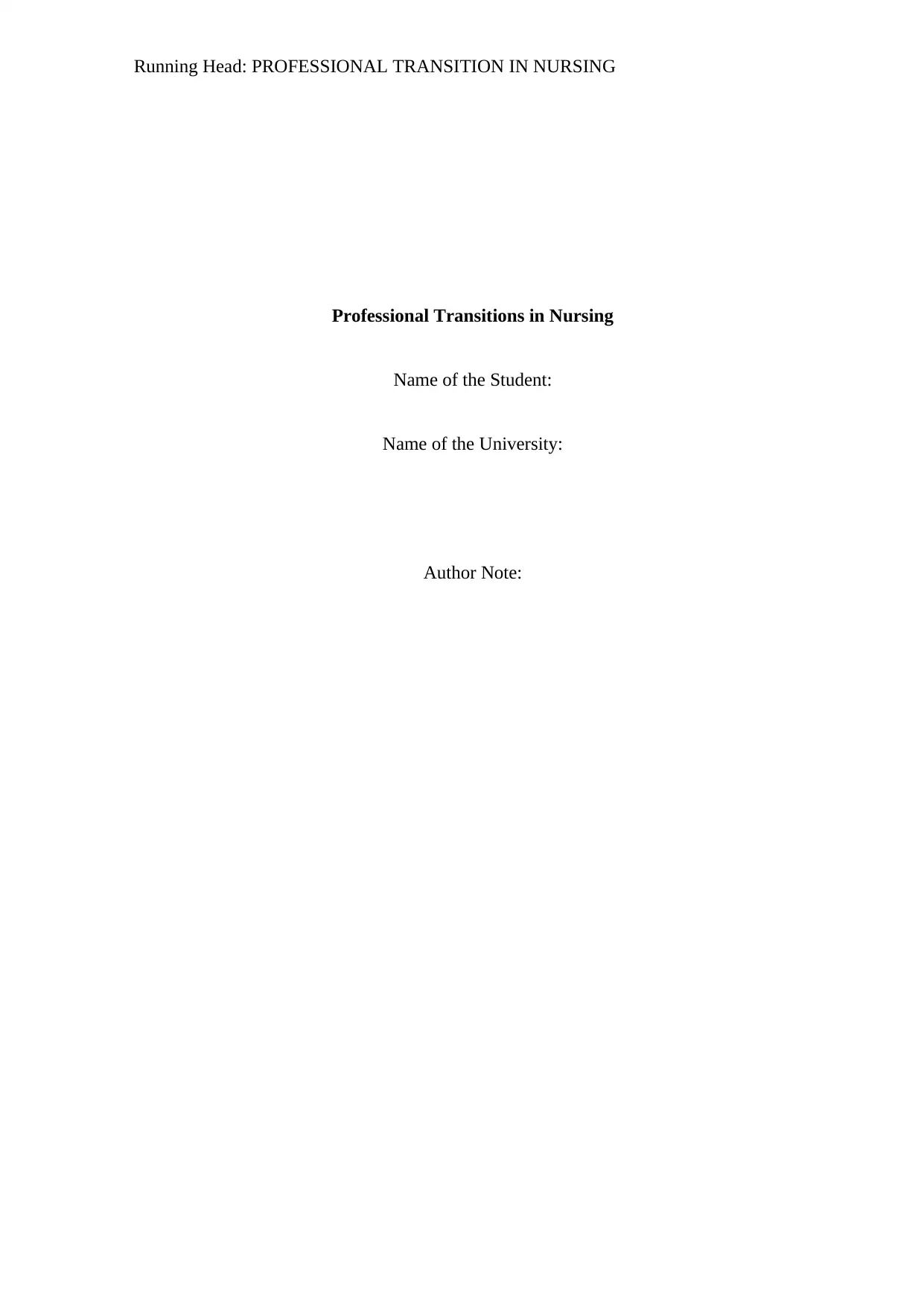
Running Head: PROFESSIONAL TRANSITION IN NURSING
Professional Transitions in Nursing
Name of the Student:
Name of the University:
Author Note:
Professional Transitions in Nursing
Name of the Student:
Name of the University:
Author Note:
Paraphrase This Document
Need a fresh take? Get an instant paraphrase of this document with our AI Paraphraser
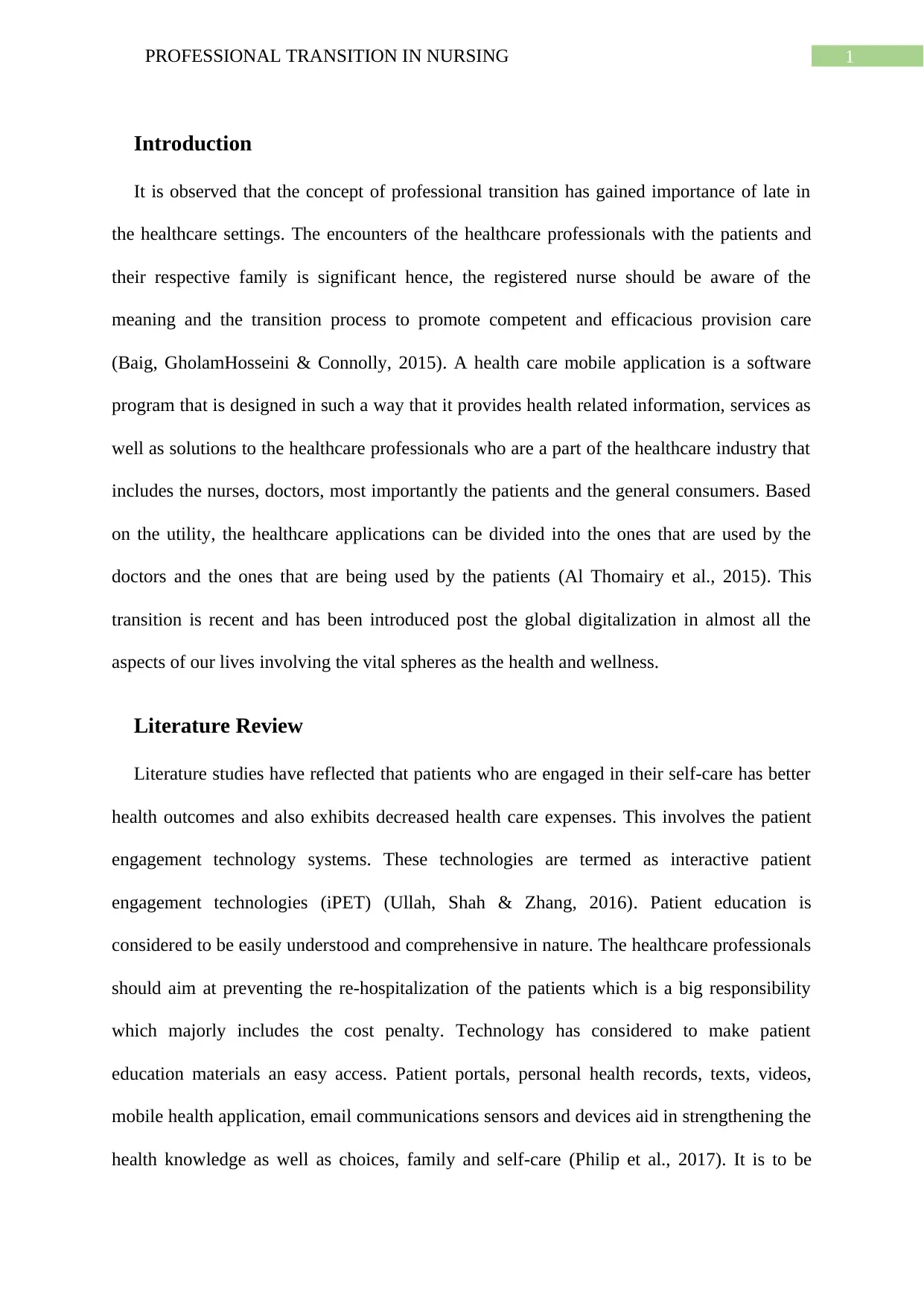
1PROFESSIONAL TRANSITION IN NURSING
Introduction
It is observed that the concept of professional transition has gained importance of late in
the healthcare settings. The encounters of the healthcare professionals with the patients and
their respective family is significant hence, the registered nurse should be aware of the
meaning and the transition process to promote competent and efficacious provision care
(Baig, GholamHosseini & Connolly, 2015). A health care mobile application is a software
program that is designed in such a way that it provides health related information, services as
well as solutions to the healthcare professionals who are a part of the healthcare industry that
includes the nurses, doctors, most importantly the patients and the general consumers. Based
on the utility, the healthcare applications can be divided into the ones that are used by the
doctors and the ones that are being used by the patients (Al Thomairy et al., 2015). This
transition is recent and has been introduced post the global digitalization in almost all the
aspects of our lives involving the vital spheres as the health and wellness.
Literature Review
Literature studies have reflected that patients who are engaged in their self-care has better
health outcomes and also exhibits decreased health care expenses. This involves the patient
engagement technology systems. These technologies are termed as interactive patient
engagement technologies (iPET) (Ullah, Shah & Zhang, 2016). Patient education is
considered to be easily understood and comprehensive in nature. The healthcare professionals
should aim at preventing the re-hospitalization of the patients which is a big responsibility
which majorly includes the cost penalty. Technology has considered to make patient
education materials an easy access. Patient portals, personal health records, texts, videos,
mobile health application, email communications sensors and devices aid in strengthening the
health knowledge as well as choices, family and self-care (Philip et al., 2017). It is to be
Introduction
It is observed that the concept of professional transition has gained importance of late in
the healthcare settings. The encounters of the healthcare professionals with the patients and
their respective family is significant hence, the registered nurse should be aware of the
meaning and the transition process to promote competent and efficacious provision care
(Baig, GholamHosseini & Connolly, 2015). A health care mobile application is a software
program that is designed in such a way that it provides health related information, services as
well as solutions to the healthcare professionals who are a part of the healthcare industry that
includes the nurses, doctors, most importantly the patients and the general consumers. Based
on the utility, the healthcare applications can be divided into the ones that are used by the
doctors and the ones that are being used by the patients (Al Thomairy et al., 2015). This
transition is recent and has been introduced post the global digitalization in almost all the
aspects of our lives involving the vital spheres as the health and wellness.
Literature Review
Literature studies have reflected that patients who are engaged in their self-care has better
health outcomes and also exhibits decreased health care expenses. This involves the patient
engagement technology systems. These technologies are termed as interactive patient
engagement technologies (iPET) (Ullah, Shah & Zhang, 2016). Patient education is
considered to be easily understood and comprehensive in nature. The healthcare professionals
should aim at preventing the re-hospitalization of the patients which is a big responsibility
which majorly includes the cost penalty. Technology has considered to make patient
education materials an easy access. Patient portals, personal health records, texts, videos,
mobile health application, email communications sensors and devices aid in strengthening the
health knowledge as well as choices, family and self-care (Philip et al., 2017). It is to be
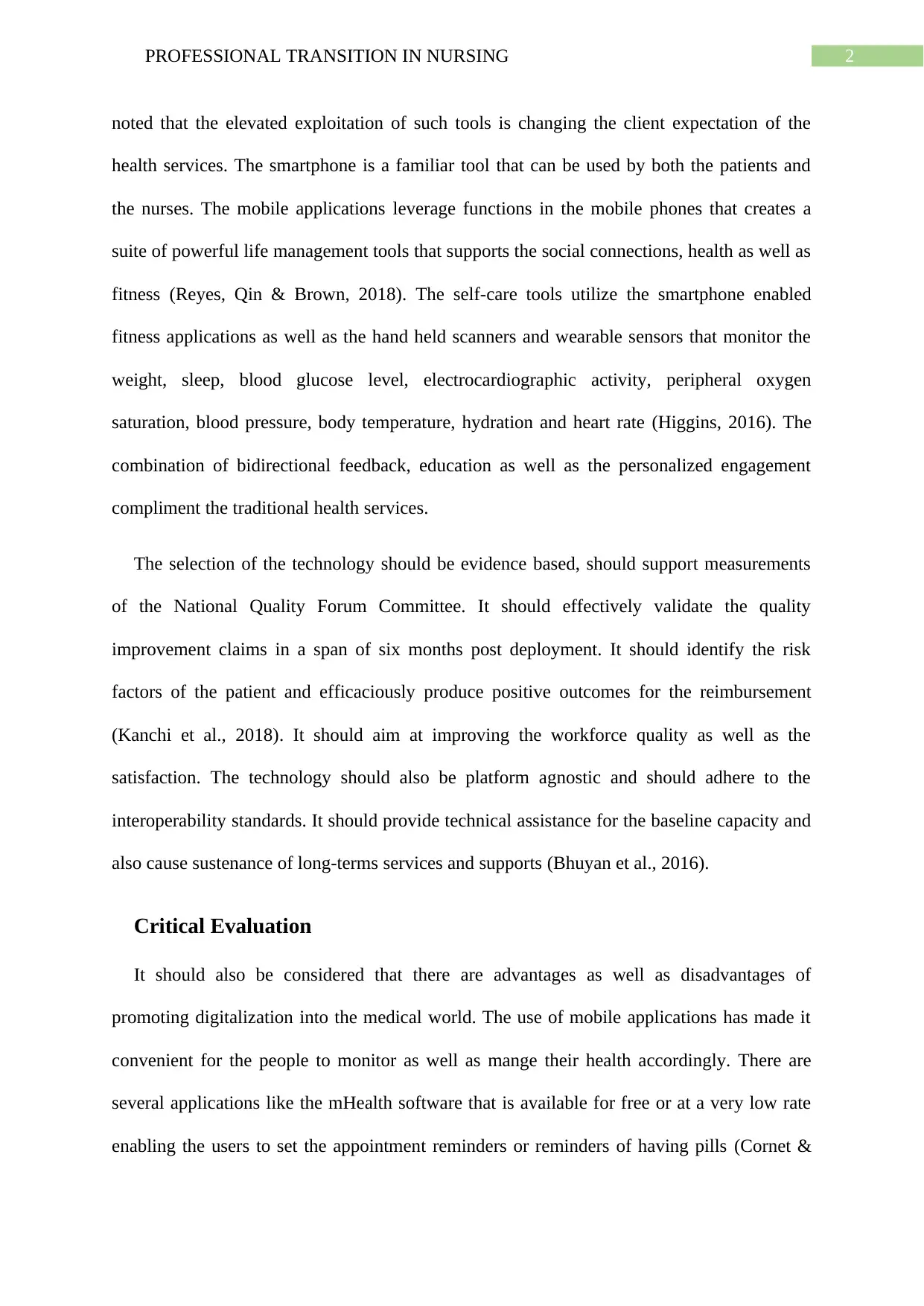
2PROFESSIONAL TRANSITION IN NURSING
noted that the elevated exploitation of such tools is changing the client expectation of the
health services. The smartphone is a familiar tool that can be used by both the patients and
the nurses. The mobile applications leverage functions in the mobile phones that creates a
suite of powerful life management tools that supports the social connections, health as well as
fitness (Reyes, Qin & Brown, 2018). The self-care tools utilize the smartphone enabled
fitness applications as well as the hand held scanners and wearable sensors that monitor the
weight, sleep, blood glucose level, electrocardiographic activity, peripheral oxygen
saturation, blood pressure, body temperature, hydration and heart rate (Higgins, 2016). The
combination of bidirectional feedback, education as well as the personalized engagement
compliment the traditional health services.
The selection of the technology should be evidence based, should support measurements
of the National Quality Forum Committee. It should effectively validate the quality
improvement claims in a span of six months post deployment. It should identify the risk
factors of the patient and efficaciously produce positive outcomes for the reimbursement
(Kanchi et al., 2018). It should aim at improving the workforce quality as well as the
satisfaction. The technology should also be platform agnostic and should adhere to the
interoperability standards. It should provide technical assistance for the baseline capacity and
also cause sustenance of long-terms services and supports (Bhuyan et al., 2016).
Critical Evaluation
It should also be considered that there are advantages as well as disadvantages of
promoting digitalization into the medical world. The use of mobile applications has made it
convenient for the people to monitor as well as mange their health accordingly. There are
several applications like the mHealth software that is available for free or at a very low rate
enabling the users to set the appointment reminders or reminders of having pills (Cornet &
noted that the elevated exploitation of such tools is changing the client expectation of the
health services. The smartphone is a familiar tool that can be used by both the patients and
the nurses. The mobile applications leverage functions in the mobile phones that creates a
suite of powerful life management tools that supports the social connections, health as well as
fitness (Reyes, Qin & Brown, 2018). The self-care tools utilize the smartphone enabled
fitness applications as well as the hand held scanners and wearable sensors that monitor the
weight, sleep, blood glucose level, electrocardiographic activity, peripheral oxygen
saturation, blood pressure, body temperature, hydration and heart rate (Higgins, 2016). The
combination of bidirectional feedback, education as well as the personalized engagement
compliment the traditional health services.
The selection of the technology should be evidence based, should support measurements
of the National Quality Forum Committee. It should effectively validate the quality
improvement claims in a span of six months post deployment. It should identify the risk
factors of the patient and efficaciously produce positive outcomes for the reimbursement
(Kanchi et al., 2018). It should aim at improving the workforce quality as well as the
satisfaction. The technology should also be platform agnostic and should adhere to the
interoperability standards. It should provide technical assistance for the baseline capacity and
also cause sustenance of long-terms services and supports (Bhuyan et al., 2016).
Critical Evaluation
It should also be considered that there are advantages as well as disadvantages of
promoting digitalization into the medical world. The use of mobile applications has made it
convenient for the people to monitor as well as mange their health accordingly. There are
several applications like the mHealth software that is available for free or at a very low rate
enabling the users to set the appointment reminders or reminders of having pills (Cornet &
⊘ This is a preview!⊘
Do you want full access?
Subscribe today to unlock all pages.

Trusted by 1+ million students worldwide
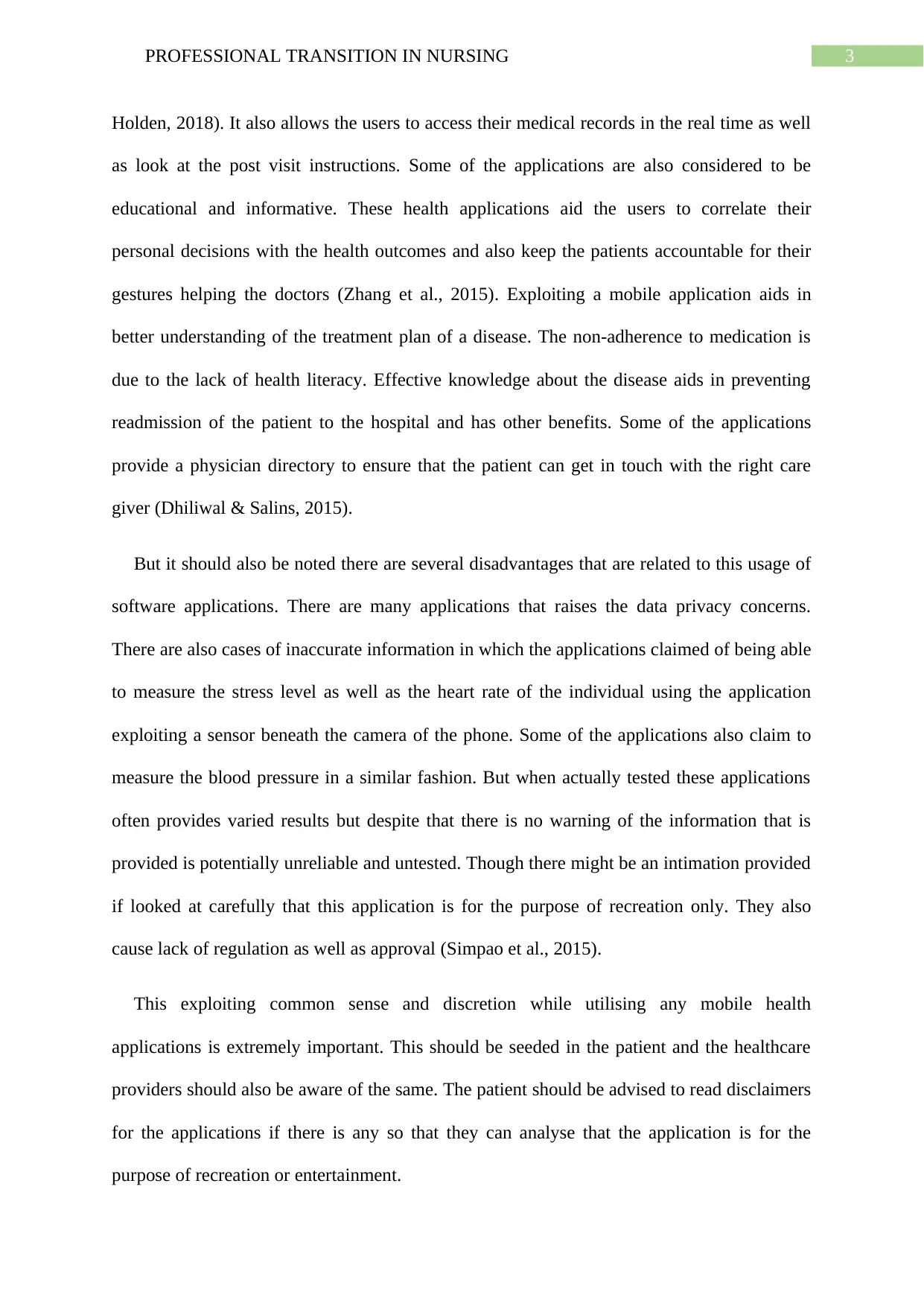
3PROFESSIONAL TRANSITION IN NURSING
Holden, 2018). It also allows the users to access their medical records in the real time as well
as look at the post visit instructions. Some of the applications are also considered to be
educational and informative. These health applications aid the users to correlate their
personal decisions with the health outcomes and also keep the patients accountable for their
gestures helping the doctors (Zhang et al., 2015). Exploiting a mobile application aids in
better understanding of the treatment plan of a disease. The non-adherence to medication is
due to the lack of health literacy. Effective knowledge about the disease aids in preventing
readmission of the patient to the hospital and has other benefits. Some of the applications
provide a physician directory to ensure that the patient can get in touch with the right care
giver (Dhiliwal & Salins, 2015).
But it should also be noted there are several disadvantages that are related to this usage of
software applications. There are many applications that raises the data privacy concerns.
There are also cases of inaccurate information in which the applications claimed of being able
to measure the stress level as well as the heart rate of the individual using the application
exploiting a sensor beneath the camera of the phone. Some of the applications also claim to
measure the blood pressure in a similar fashion. But when actually tested these applications
often provides varied results but despite that there is no warning of the information that is
provided is potentially unreliable and untested. Though there might be an intimation provided
if looked at carefully that this application is for the purpose of recreation only. They also
cause lack of regulation as well as approval (Simpao et al., 2015).
This exploiting common sense and discretion while utilising any mobile health
applications is extremely important. This should be seeded in the patient and the healthcare
providers should also be aware of the same. The patient should be advised to read disclaimers
for the applications if there is any so that they can analyse that the application is for the
purpose of recreation or entertainment.
Holden, 2018). It also allows the users to access their medical records in the real time as well
as look at the post visit instructions. Some of the applications are also considered to be
educational and informative. These health applications aid the users to correlate their
personal decisions with the health outcomes and also keep the patients accountable for their
gestures helping the doctors (Zhang et al., 2015). Exploiting a mobile application aids in
better understanding of the treatment plan of a disease. The non-adherence to medication is
due to the lack of health literacy. Effective knowledge about the disease aids in preventing
readmission of the patient to the hospital and has other benefits. Some of the applications
provide a physician directory to ensure that the patient can get in touch with the right care
giver (Dhiliwal & Salins, 2015).
But it should also be noted there are several disadvantages that are related to this usage of
software applications. There are many applications that raises the data privacy concerns.
There are also cases of inaccurate information in which the applications claimed of being able
to measure the stress level as well as the heart rate of the individual using the application
exploiting a sensor beneath the camera of the phone. Some of the applications also claim to
measure the blood pressure in a similar fashion. But when actually tested these applications
often provides varied results but despite that there is no warning of the information that is
provided is potentially unreliable and untested. Though there might be an intimation provided
if looked at carefully that this application is for the purpose of recreation only. They also
cause lack of regulation as well as approval (Simpao et al., 2015).
This exploiting common sense and discretion while utilising any mobile health
applications is extremely important. This should be seeded in the patient and the healthcare
providers should also be aware of the same. The patient should be advised to read disclaimers
for the applications if there is any so that they can analyse that the application is for the
purpose of recreation or entertainment.
Paraphrase This Document
Need a fresh take? Get an instant paraphrase of this document with our AI Paraphraser
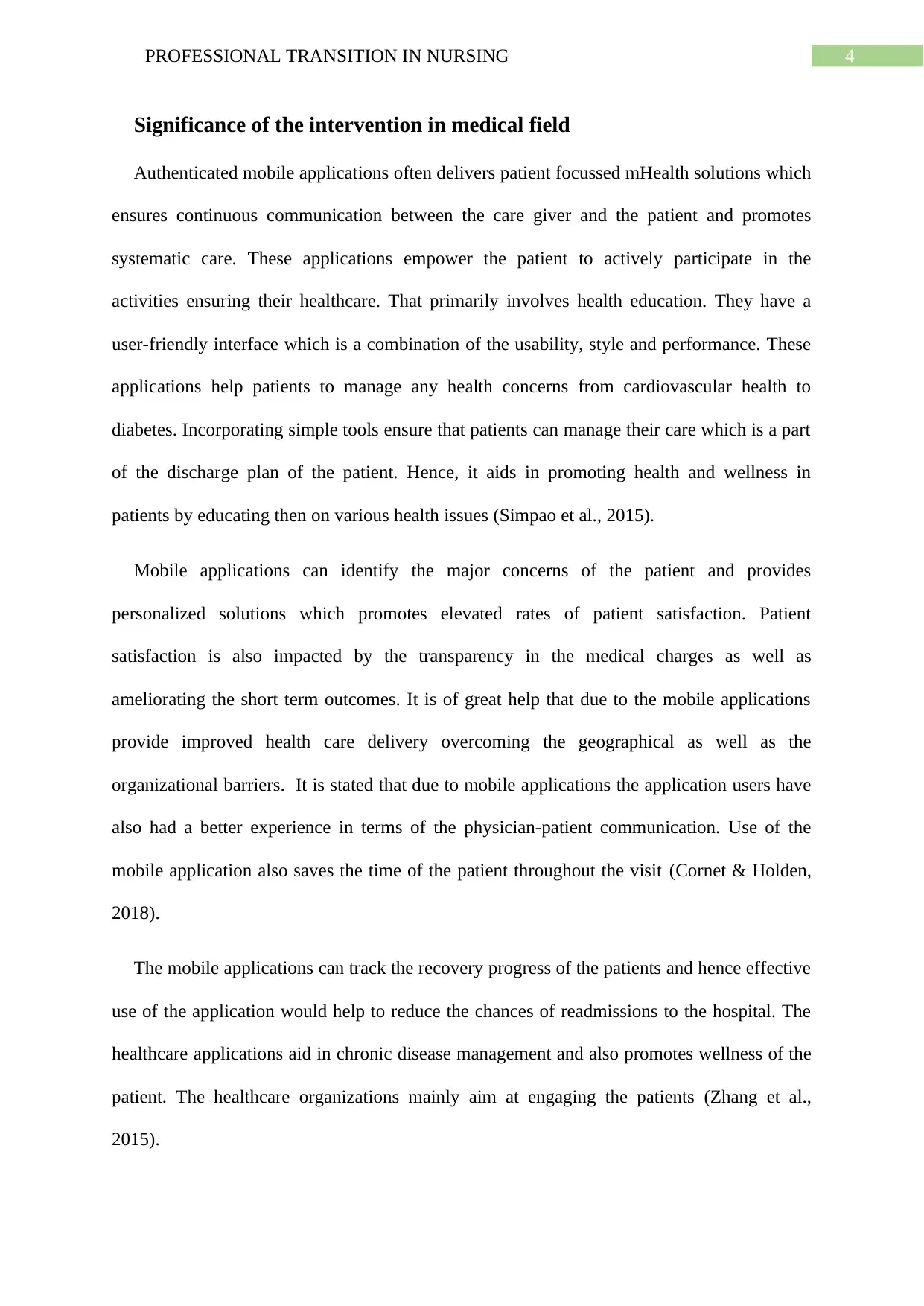
4PROFESSIONAL TRANSITION IN NURSING
Significance of the intervention in medical field
Authenticated mobile applications often delivers patient focussed mHealth solutions which
ensures continuous communication between the care giver and the patient and promotes
systematic care. These applications empower the patient to actively participate in the
activities ensuring their healthcare. That primarily involves health education. They have a
user-friendly interface which is a combination of the usability, style and performance. These
applications help patients to manage any health concerns from cardiovascular health to
diabetes. Incorporating simple tools ensure that patients can manage their care which is a part
of the discharge plan of the patient. Hence, it aids in promoting health and wellness in
patients by educating then on various health issues (Simpao et al., 2015).
Mobile applications can identify the major concerns of the patient and provides
personalized solutions which promotes elevated rates of patient satisfaction. Patient
satisfaction is also impacted by the transparency in the medical charges as well as
ameliorating the short term outcomes. It is of great help that due to the mobile applications
provide improved health care delivery overcoming the geographical as well as the
organizational barriers. It is stated that due to mobile applications the application users have
also had a better experience in terms of the physician-patient communication. Use of the
mobile application also saves the time of the patient throughout the visit (Cornet & Holden,
2018).
The mobile applications can track the recovery progress of the patients and hence effective
use of the application would help to reduce the chances of readmissions to the hospital. The
healthcare applications aid in chronic disease management and also promotes wellness of the
patient. The healthcare organizations mainly aim at engaging the patients (Zhang et al.,
2015).
Significance of the intervention in medical field
Authenticated mobile applications often delivers patient focussed mHealth solutions which
ensures continuous communication between the care giver and the patient and promotes
systematic care. These applications empower the patient to actively participate in the
activities ensuring their healthcare. That primarily involves health education. They have a
user-friendly interface which is a combination of the usability, style and performance. These
applications help patients to manage any health concerns from cardiovascular health to
diabetes. Incorporating simple tools ensure that patients can manage their care which is a part
of the discharge plan of the patient. Hence, it aids in promoting health and wellness in
patients by educating then on various health issues (Simpao et al., 2015).
Mobile applications can identify the major concerns of the patient and provides
personalized solutions which promotes elevated rates of patient satisfaction. Patient
satisfaction is also impacted by the transparency in the medical charges as well as
ameliorating the short term outcomes. It is of great help that due to the mobile applications
provide improved health care delivery overcoming the geographical as well as the
organizational barriers. It is stated that due to mobile applications the application users have
also had a better experience in terms of the physician-patient communication. Use of the
mobile application also saves the time of the patient throughout the visit (Cornet & Holden,
2018).
The mobile applications can track the recovery progress of the patients and hence effective
use of the application would help to reduce the chances of readmissions to the hospital. The
healthcare applications aid in chronic disease management and also promotes wellness of the
patient. The healthcare organizations mainly aim at engaging the patients (Zhang et al.,
2015).
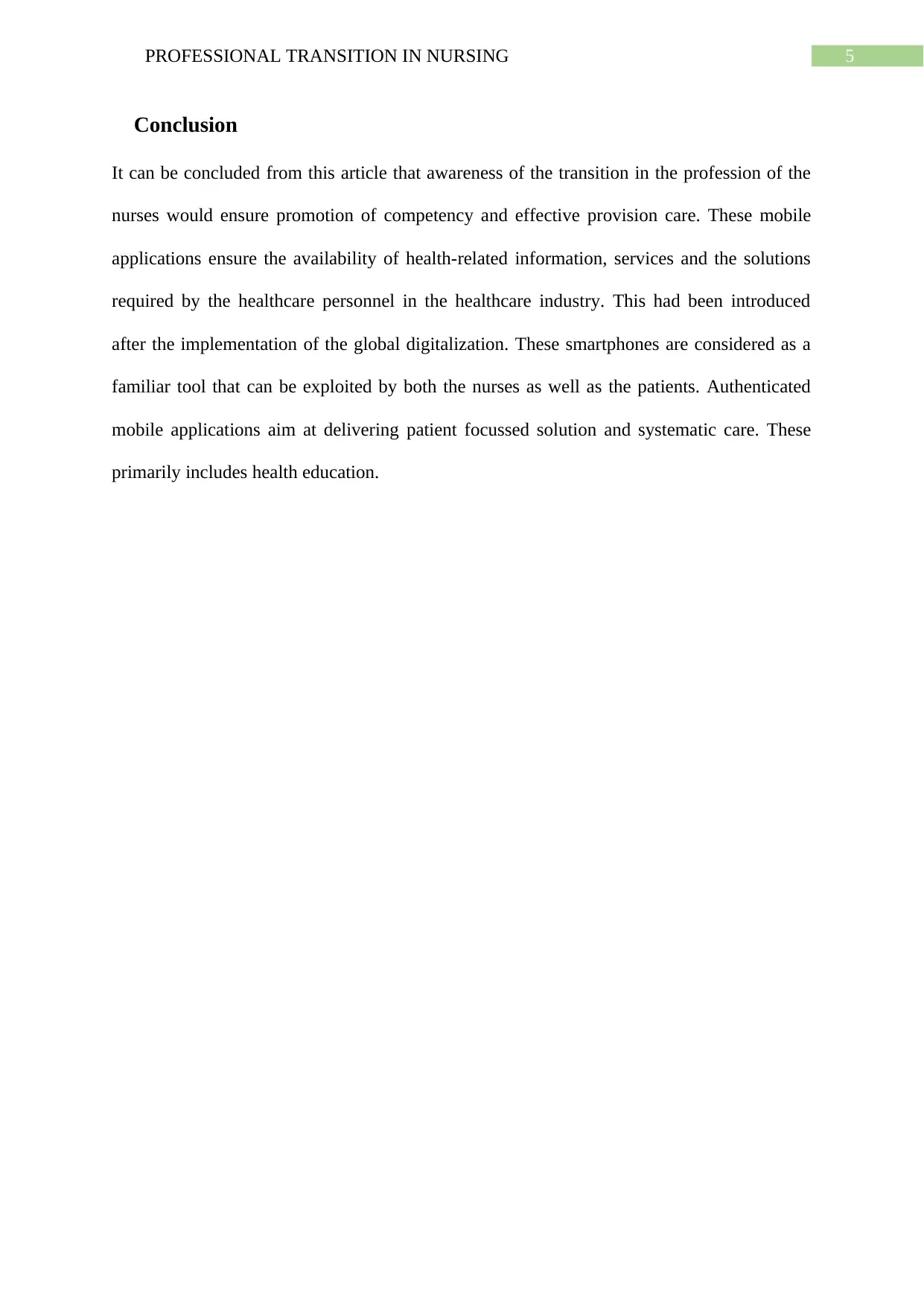
5PROFESSIONAL TRANSITION IN NURSING
Conclusion
It can be concluded from this article that awareness of the transition in the profession of the
nurses would ensure promotion of competency and effective provision care. These mobile
applications ensure the availability of health-related information, services and the solutions
required by the healthcare personnel in the healthcare industry. This had been introduced
after the implementation of the global digitalization. These smartphones are considered as a
familiar tool that can be exploited by both the nurses as well as the patients. Authenticated
mobile applications aim at delivering patient focussed solution and systematic care. These
primarily includes health education.
Conclusion
It can be concluded from this article that awareness of the transition in the profession of the
nurses would ensure promotion of competency and effective provision care. These mobile
applications ensure the availability of health-related information, services and the solutions
required by the healthcare personnel in the healthcare industry. This had been introduced
after the implementation of the global digitalization. These smartphones are considered as a
familiar tool that can be exploited by both the nurses as well as the patients. Authenticated
mobile applications aim at delivering patient focussed solution and systematic care. These
primarily includes health education.
⊘ This is a preview!⊘
Do you want full access?
Subscribe today to unlock all pages.

Trusted by 1+ million students worldwide
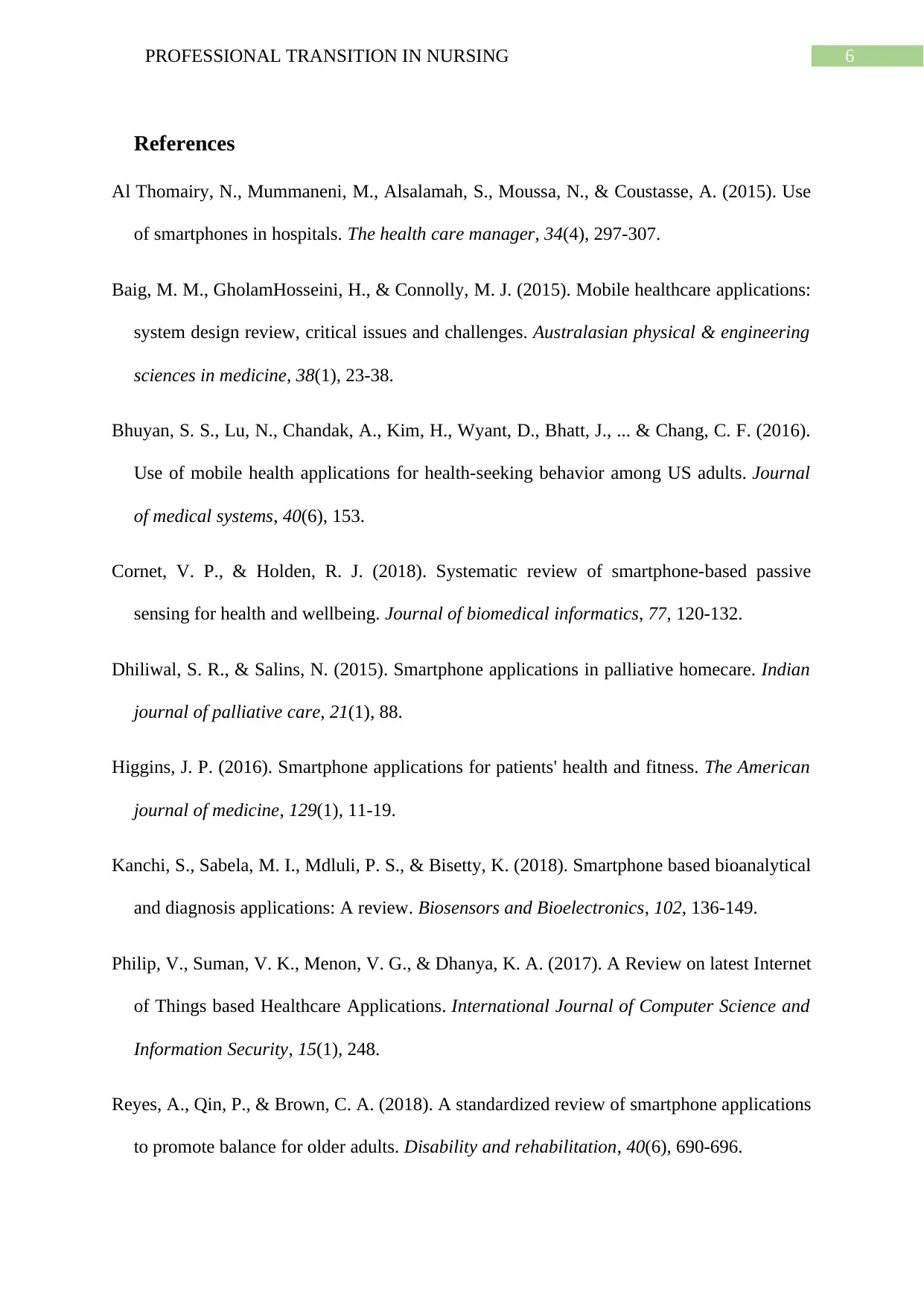
6PROFESSIONAL TRANSITION IN NURSING
References
Al Thomairy, N., Mummaneni, M., Alsalamah, S., Moussa, N., & Coustasse, A. (2015). Use
of smartphones in hospitals. The health care manager, 34(4), 297-307.
Baig, M. M., GholamHosseini, H., & Connolly, M. J. (2015). Mobile healthcare applications:
system design review, critical issues and challenges. Australasian physical & engineering
sciences in medicine, 38(1), 23-38.
Bhuyan, S. S., Lu, N., Chandak, A., Kim, H., Wyant, D., Bhatt, J., ... & Chang, C. F. (2016).
Use of mobile health applications for health-seeking behavior among US adults. Journal
of medical systems, 40(6), 153.
Cornet, V. P., & Holden, R. J. (2018). Systematic review of smartphone-based passive
sensing for health and wellbeing. Journal of biomedical informatics, 77, 120-132.
Dhiliwal, S. R., & Salins, N. (2015). Smartphone applications in palliative homecare. Indian
journal of palliative care, 21(1), 88.
Higgins, J. P. (2016). Smartphone applications for patients' health and fitness. The American
journal of medicine, 129(1), 11-19.
Kanchi, S., Sabela, M. I., Mdluli, P. S., & Bisetty, K. (2018). Smartphone based bioanalytical
and diagnosis applications: A review. Biosensors and Bioelectronics, 102, 136-149.
Philip, V., Suman, V. K., Menon, V. G., & Dhanya, K. A. (2017). A Review on latest Internet
of Things based Healthcare Applications. International Journal of Computer Science and
Information Security, 15(1), 248.
Reyes, A., Qin, P., & Brown, C. A. (2018). A standardized review of smartphone applications
to promote balance for older adults. Disability and rehabilitation, 40(6), 690-696.
References
Al Thomairy, N., Mummaneni, M., Alsalamah, S., Moussa, N., & Coustasse, A. (2015). Use
of smartphones in hospitals. The health care manager, 34(4), 297-307.
Baig, M. M., GholamHosseini, H., & Connolly, M. J. (2015). Mobile healthcare applications:
system design review, critical issues and challenges. Australasian physical & engineering
sciences in medicine, 38(1), 23-38.
Bhuyan, S. S., Lu, N., Chandak, A., Kim, H., Wyant, D., Bhatt, J., ... & Chang, C. F. (2016).
Use of mobile health applications for health-seeking behavior among US adults. Journal
of medical systems, 40(6), 153.
Cornet, V. P., & Holden, R. J. (2018). Systematic review of smartphone-based passive
sensing for health and wellbeing. Journal of biomedical informatics, 77, 120-132.
Dhiliwal, S. R., & Salins, N. (2015). Smartphone applications in palliative homecare. Indian
journal of palliative care, 21(1), 88.
Higgins, J. P. (2016). Smartphone applications for patients' health and fitness. The American
journal of medicine, 129(1), 11-19.
Kanchi, S., Sabela, M. I., Mdluli, P. S., & Bisetty, K. (2018). Smartphone based bioanalytical
and diagnosis applications: A review. Biosensors and Bioelectronics, 102, 136-149.
Philip, V., Suman, V. K., Menon, V. G., & Dhanya, K. A. (2017). A Review on latest Internet
of Things based Healthcare Applications. International Journal of Computer Science and
Information Security, 15(1), 248.
Reyes, A., Qin, P., & Brown, C. A. (2018). A standardized review of smartphone applications
to promote balance for older adults. Disability and rehabilitation, 40(6), 690-696.
Paraphrase This Document
Need a fresh take? Get an instant paraphrase of this document with our AI Paraphraser
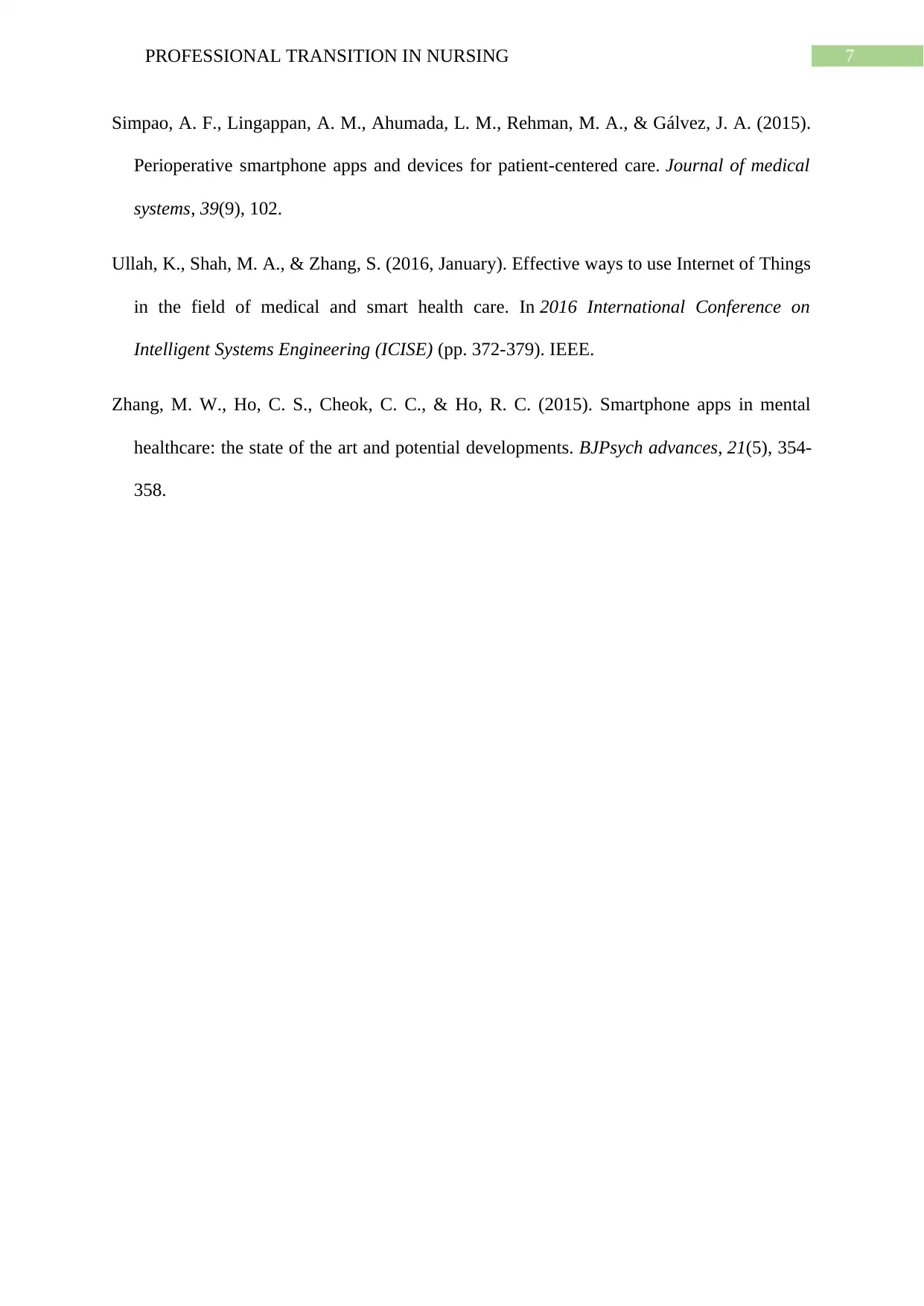
7PROFESSIONAL TRANSITION IN NURSING
Simpao, A. F., Lingappan, A. M., Ahumada, L. M., Rehman, M. A., & Gálvez, J. A. (2015).
Perioperative smartphone apps and devices for patient-centered care. Journal of medical
systems, 39(9), 102.
Ullah, K., Shah, M. A., & Zhang, S. (2016, January). Effective ways to use Internet of Things
in the field of medical and smart health care. In 2016 International Conference on
Intelligent Systems Engineering (ICISE) (pp. 372-379). IEEE.
Zhang, M. W., Ho, C. S., Cheok, C. C., & Ho, R. C. (2015). Smartphone apps in mental
healthcare: the state of the art and potential developments. BJPsych advances, 21(5), 354-
358.
Simpao, A. F., Lingappan, A. M., Ahumada, L. M., Rehman, M. A., & Gálvez, J. A. (2015).
Perioperative smartphone apps and devices for patient-centered care. Journal of medical
systems, 39(9), 102.
Ullah, K., Shah, M. A., & Zhang, S. (2016, January). Effective ways to use Internet of Things
in the field of medical and smart health care. In 2016 International Conference on
Intelligent Systems Engineering (ICISE) (pp. 372-379). IEEE.
Zhang, M. W., Ho, C. S., Cheok, C. C., & Ho, R. C. (2015). Smartphone apps in mental
healthcare: the state of the art and potential developments. BJPsych advances, 21(5), 354-
358.
1 out of 8
Related Documents
Your All-in-One AI-Powered Toolkit for Academic Success.
+13062052269
info@desklib.com
Available 24*7 on WhatsApp / Email
![[object Object]](/_next/static/media/star-bottom.7253800d.svg)
Unlock your academic potential
Copyright © 2020–2025 A2Z Services. All Rights Reserved. Developed and managed by ZUCOL.





